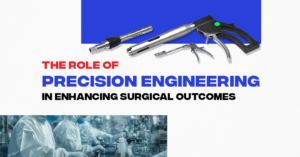In the ever-evolving landscape of modern medicine, precision engineering has become a cornerstone of surgical innovation. This field, dedicated to achieving the highest levels of accuracy and reliability, is profoundly transforming how surgical procedures are performed. By integrating principles of precision engineering into surgery, healthcare professionals are achieving remarkable improvements in patient outcomes, minimising complications, and optimising the effectiveness of treatments. This blog delves deeper into how precision engineering is revolutionising surgical practice and shaping the future of healthcare.
Precision engineering focuses on the design and development of highly accurate and dependable tools, systems, and technologies. In the context of surgery, this discipline translates into the creation of sophisticated instruments and techniques that enhance the precision of surgical procedures. The ultimate goal is to reduce errors, enhance performance, and ensure that every aspect of a surgical intervention is executed with meticulous accuracy.
Key Contributions of Precision Engineering to Surgical Outcomes
1. Development of High-Precision Surgical Instruments
– Advancements in Tool Design: Precision engineering has led to the creation of surgical instruments that are unparalleled in their accuracy and reliability. For instance, robotic surgical systems, advanced endoscopic tools, and high-definition imaging devices are designed to perform delicate and complex tasks with minimal deviation from the intended course.
– Impact on Surgical Precision: The use of these high-precision tools allows surgeons to execute procedures with greater control and finesse. This results in reduced tissue damage, fewer complications, and improved overall outcomes. For example, robotic arms equipped with advanced sensors can perform tasks with micrometre-level accuracy, significantly enhancing surgical precision.
2. Robotic-Assisted Surgery
– Revolutionising Surgical Precision: Robotic-assisted surgery represents a significant leap forward in precision engineering. Surgical robots are equipped with robotic arms that offer exceptional precision and control. Surgeons manipulate these arms using a console that translates their movements into highly accurate actions by the robot.
– Patient Benefits: The precision of robotic systems enables surgeons to perform complex procedures with smaller incisions, which reduces blood loss and minimises post-operative pain. The enhanced dexterity and control provided by robotics allow for intricate manoeuvres that were previously challenging with conventional methods. For example, robotic-assisted prostatectomy has become a standard approach for treating prostate cancer, thanks to its precision and reduced recovery time.
3. Integration of Real-Time Imaging Technologies
– Advanced Imaging Modalities: Precision engineering has significantly enhanced surgical planning and execution through the integration of real-time imaging technologies. Intraoperative imaging techniques, such as CT scans, MRI, and fluoroscopy, provide surgeons with continuous visual feedback during procedures.
– Improving Surgical Accuracy: Real-time imaging allows surgeons to visualise anatomical structures with remarkable clarity and make real-time adjustments during surgery. This guidance is crucial for accurate placement of implants, precise removal of tumours, and careful navigation of delicate tissues. For instance, in spinal surgeries, real-time imaging helps in precise screw placement and alignment, reducing the risk of postoperative complications.
4. Customization and Personalization in Surgery
– Tailored Surgical Solutions: Precision engineering enables the development of customised surgical solutions tailored to individual patients. This includes custom implants, patient-specific surgical guides, and personalised surgical plans based on detailed anatomical data.
– Enhancing Outcomes: Customization improves the fit and functionality of implants, ensuring optimal alignment and integration with the patient’s unique anatomy. Personalised surgical plans allow for precise targeting of problem areas, enhancing the effectiveness of the procedure and minimising the risk of complications. For example, custom-fit joint replacements can lead to better functional outcomes and reduced wear and tear compared to standard implants.
5. Advancements in Minimally Invasive Surgery
– Precision in Minimally Invasive Techniques: Minimally invasive surgeries rely heavily on precision engineering to achieve successful outcomes with smaller incisions. Techniques such as laparoscopic surgery and endoscopic procedures utilise advanced instruments and imaging technologies to perform surgeries through tiny openings.
– Patient-Centric Benefits: The use of precision-engineered instruments in minimally invasive procedures results in shorter recovery times, reduced postoperative pain, and fewer complications compared to traditional open surgeries. For example, laparoscopic cholecystectomy for gallbladder removal offers significant advantages over open surgery, including less scarring and quicker return to daily activities.
The Future of Precision Engineering in Surgery
The future of precision engineering in surgery promises to be even more transformative, driven by ongoing technological advancements and innovations:
– Next-Generation Robotic Systems: Future robotic surgical systems are expected to offer even greater precision, flexibility, and integration with advanced imaging technologies. These systems may incorporate artificial intelligence to enhance decision-making and provide real-time feedback during surgery.
– Enhanced Imaging Technologies: Emerging imaging modalities will provide even more detailed and accurate views of the surgical field, improving the precision of interventions and allowing for more complex procedures to be performed with greater confidence.
– Integration of Artificial Intelligence: Artificial intelligence (AI) has the potential to revolutionise surgical precision by offering predictive analytics, real-time adjustments, and enhanced planning tools. AI-driven systems could assist in identifying optimal surgical approaches and predicting potential complications before they arise.
Precision engineering is playing a transformative role in enhancing surgical outcomes by providing surgeons with the tools, technologies, and techniques needed to perform procedures with exceptional accuracy. From the development of high-precision instruments and robotic systems to the integration of real-time imaging and personalised solutions, precision engineering is driving significant improvements in patient care. As technology continues to evolve, the future of surgical precision holds the promise of even greater advancements, leading to better outcomes and an improved quality of life for patients worldwide. The continued integration of precision engineering into surgical practice represents a significant step forward in the quest for safer, more effective, and patient-centred healthcare.
visit our website now now to know more.

